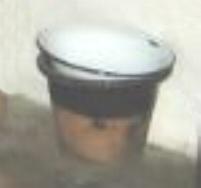|
|
The number of cows kept
depended on the size of the farm, most small farmers had one
cow this supplied milk and butter at least for part of the
year.  The cow would be
milked and the milk stored in a crock 'A large flowerpot shaped
crockery container holding about x liters (x gallons)', when
left to stand the cream rose to the surface and would be skimmed
off and stored in another crock to be made into butter. The cow would be
milked and the milk stored in a crock 'A large flowerpot shaped
crockery container holding about x liters (x gallons)', when
left to stand the cream rose to the surface and would be skimmed
off and stored in another crock to be made into butter.
The crocks were usually kept in a larder
with a stone flagged floor, this helped to keep the milk cool.
Eggs were also stored in crocks for the same reason.
Butter was made in a churn, there were
two types, the simplest resembled a large wooden bucket with
a close fitting lid which had a hole in the centre, the cream
was put into the churn and before the lid was fitted a wooden
rod with a paddle was inserted through the hole, this was
plunged up and down until the butter was made.  The other which came
much later was a small wooden barrel, this has a tightly fitting
lid, with a little glass viewing lens, and a push button valve
to release the pressure, the barrel had steel trunnions 'Axles'
bolted to its sides, these trunnions rested in bearings which
were set on top of a wooden frame, one of the trunnions was
extended and a handle was attached to it. When the handle
was rotated The other which came
much later was a small wooden barrel, this has a tightly fitting
lid, with a little glass viewing lens, and a push button valve
to release the pressure, the barrel had steel trunnions 'Axles'
bolted to its sides, these trunnions rested in bearings which
were set on top of a wooden frame, one of the trunnions was
extended and a handle was attached to it. When the handle
was rotated  the barrel turned end over
end tossing the cream and converting it into butter. the barrel turned end over
end tossing the cream and converting it into butter.
When the process was complete the butter
would be floating in the 'butter milk' in small lumps, this
would be strained off through muslin and the butter formed
into blocks with butter pats 'small wooden spade shaped implement
with a short handle.' The buttermilk was used to bake soda
bread using white flour or wheaten, using whole meal flour,
the buttermilk would also be drunk with meals, if you have
ever tried drinking today's buttermilk and not been particularly
impressed, it bears little resemblance in taste and texture
to that which was produced on the farm.
|













